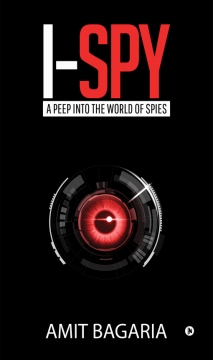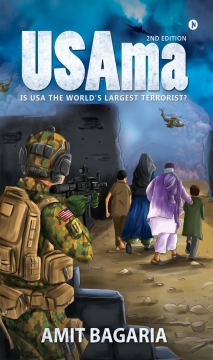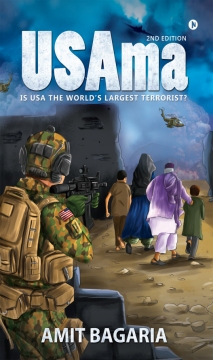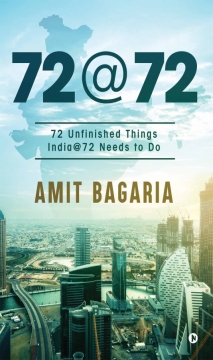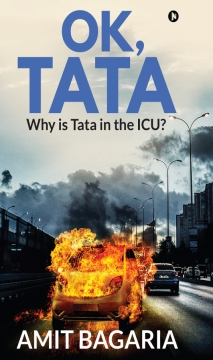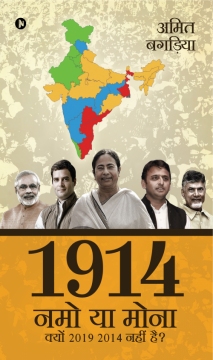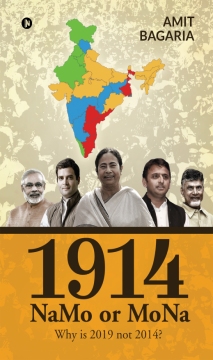
- Discover books
- For Writers
-
For Writers
-
Indie Author Championship
-
Challenges
Writing Contests
- Get Started

"It was a wonderful experience interacting with you and appreciate the way you have planned and executed the whole publication process within the agreed timelines.”
Subrat SaurabhAuthor of Kuch Woh Pal -
-
-
IN
- India
- Singapore
- Malaysia
- 0
Amit Bagaria
Bengaluru-based Amit Bagaria is a serial entrepreneur turned serial author. He has written nine nonfiction books since November 2017 and has sold almost 7,000 copies since April 2018. He has received a lot of praise from dozens of book lovers and serial book reviewers for five of those nine titles. This is his first fiction novel. Read More...
Bengaluru-based Amit Bagaria is a serial entrepreneur turned serial author. He has written nine nonfiction books since November 2017 and has sold almost 7,000 copies since April 2018. He has received a lot of praise from dozens of book lovers and serial book reviewers for five of those nine titles. This is his first fiction novel.
Read Less...Crop your profile image

Spies, Lies & Red Tape
Books by Amit Bagaria
The Gang of Six were clinching their fists under the 21-seater oval teak table in the PMO in New Delhi. How could their Prime Minister speak to them like that? How does the Constitution of India allow such people, with just 35 seats out of 543 in the Lok Sabha, to become the PM?
The Indian PM’s aircraft took off from Islamabad Airport at 7:45 am IST and was scheduled to land at the Indira Gandhi International Airport (IGIA) in New D
The Gang of Six were clinching their fists under the 21-seater oval teak table in the PMO in New Delhi. How could their Prime Minister speak to them like that? How does the Constitution of India allow such people, with just 35 seats out of 543 in the Lok Sabha, to become the PM?
The Indian PM’s aircraft took off from Islamabad Airport at 7:45 am IST and was scheduled to land at the Indira Gandhi International Airport (IGIA) in New Delhi at 9:10 am IST. When the aircraft started deviating from its scheduled route, there was panic at the IGIA air traffic control tower. By 9:15 am IST, the aircraft was seen heading south, when it became out of range of the radars at IGIA. Had the PM’s aircraft been hijacked? Was it headed to Sri Lanka or the Maldives?
The defence minister, external affairs minister and the NSA had accompanied the PM to Islamabad. In their absence, the best men to contact the Indian Air Force Chief were the cabinet secretary or the defence secretary. Both men tried to get hold of him, but to no avail. He was not answering his office or mobile phone. They tried the Vice Chief and got no response either. What in hell was going on?
By 9:45 am IST, Indian Army soldiers in battle gear began arriving in army trucks at North and South Block, and at various other ministry buildings spread across Lutyens’ Delhi. Hundreds of soldiers also arrived at the residences of the union ministers in the 28.7 km2 Lutyens Bungalow Zone.
At 9:45 pm Pakistan Time, about five hours after the Indian generals had finished the press conference in New Delhi and about two hours after millions had started demonstrating on roads across fifty-plus Indian cities, Prime Minister Irfan Khan chaired a meeting of Pakistan’s National Security Council. A plan of action was framed.
I-SPY (PB)
Books by Amit Bagaria
The name is Bond – JAMES BOND. I am sure you’ve seen at least one, if not more of the 26 films made on fictional British spy 007. You may’ve also seen TV shows like The Americans, Blindspot, Chuck, Covert Affairs, Homeland, Nikita, Quantico, The Blacklist, and/or The Night Manager. I wrote this book after I realised that the average person may not know even one-six
The name is Bond – JAMES BOND. I am sure you’ve seen at least one, if not more of the 26 films made on fictional British spy 007. You may’ve also seen TV shows like The Americans, Blindspot, Chuck, Covert Affairs, Homeland, Nikita, Quantico, The Blacklist, and/or The Night Manager. I wrote this book after I realised that the average person may not know even one-sixth of what I know about spies and spying.
Almost each of the Top 50 nations (by GDP, population or military power) has a spy agency/service. Many countries have more than one ‘secret service’ or ‘intelligence agency’. USA has 16. Some countries’ spy agencies are more powerful than entire smaller nations, with annual budgets larger than their GDPs.
This books attempts to tell the story of 20 of the world’s largest and most powerful spy agencies, details their important missions, reveals their darkest secrets, and gives you an inside perspective of the often quite gory but thrilling ‘world of spies’. It gives you a 360º view of those spy agencies you only read about or see in a movie or TV show. With one chapter per agency, you can read only chapters you may be interested in.
The life of most spies is not as glamorous as it is made out to be. You may think it is all about high-tech and guns and car chases and ‘hot’ women, but that’s not the case. In the real spy world, the techniques boil down to the interpretation of basic human psychology. Even though a spy learns several action techniques on how to get out of a dangerous situation, including how to withstand torture, if he/she is resorting to car chases, it means they’re doing something wrong.
Spies don’t get paid very well. Gambling at a casino or flying on a private jet may be part of the job, but a spy doesn’t get to spend this kind of money on personal expenses. Spies cannot disclose the nature of their work to their family and friends, to maintain secrecy. Many have to live away from home for weeks, months, even years. Married life is a mess, as the spouse starts suspecting the spy of having an affair.
Who can become a spy? Do you need a law enforcement (police) or military background? Not really. Spies have degrees as diverse as law, political science, finance, economics – even professional athletes have become successful spies.
USAma 2nd Edition (PB)
Books by Amit Bagaria
NO! This is NOT a book about Usama bin Ladin (aka Osama bin Laden). Though he was considered the world’s No.1 terrorist for nearly 10 years, bin Laden was responsible for the deaths of less than 6000 people.
The protagonist in this book is responsible for the deaths of at least 7.3 million people since World War II, not including an estimated 177,000 people killed in the Hiroshima and Nagasaki atomic bombings.
In this spine-chilling book, Amit Ba
NO! This is NOT a book about Usama bin Ladin (aka Osama bin Laden). Though he was considered the world’s No.1 terrorist for nearly 10 years, bin Laden was responsible for the deaths of less than 6000 people.
The protagonist in this book is responsible for the deaths of at least 7.3 million people since World War II, not including an estimated 177,000 people killed in the Hiroshima and Nagasaki atomic bombings.
In this spine-chilling book, Amit Bagaria takes us through an extraordinary journey of illegal/immoral acts carried out by Unjust Satan America (USA) against 82 sovereign nations, which are mostly unknown to the average reader even within USA. He tries to show us how, in one way or the other, USA has bullied its way to global dominance – interfering in our day to day lives, working perhaps for the benefit of only its super powerful Military Industrial Complex – which he describes in detail.
“USAma” is a term Bagaria has coined to describe USA. Either through drones or airstrikes, surgical strikes or full-scale military invasions, USAma has created havoc in more than half the world, he says. In other countries, different types of weapons have been used – from porn films to poison, from blackmailing to torture, from fake news to fake public protests – all through CIA.
Even the most educated amongst us have been made to believe that USA is justified – as the global policeman – in helping weaker nations fight evil, whether in the form of Communism or Islamism. This is despite the fact that, to serve its own selfish purposes, USA has supported some of the most brutal dictators, helped in the establishment of fundamentalist Islamic regimes, and even supported Communist regimes in some cases. THAT is the power of American propaganda.
USAma (2nd Edition)
Books by Amit Bagaria
NO! This is NOT a book about Usama bin Ladin (aka Osama bin Laden). Though he was considered the world’s No.1 terrorist for nearly 10 years, bin Laden was responsible for the deaths of less than 6000 people.
The protagonist in this book is responsible for the deaths of at least 7.3 million people since World War II, not including an estimated 177,000 people killed in the Hiroshima and Nagasaki atomic bombing
NO! This is NOT a book about Usama bin Ladin (aka Osama bin Laden). Though he was considered the world’s No.1 terrorist for nearly 10 years, bin Laden was responsible for the deaths of less than 6000 people.
The protagonist in this book is responsible for the deaths of at least 7.3 million people since World War II, not including an estimated 177,000 people killed in the Hiroshima and Nagasaki atomic bombings.
In this spine-chilling book, Amit Bagaria takes us through an extraordinary journey of illegal/immoral acts carried out by Unjust Satan America (USA) against 82 sovereign nations, which are mostly unknown to the average reader even within USA. He tries to show us how, in one way or the other, USA has bullied its way to global dominance – interfering in our day to day lives, working perhaps for the benefit of only its super powerful Military Industrial Complex – which he describes in detail.
“USAma” is a term Bagaria has coined to describe USA. Either through drones or airstrikes, surgical strikes or full-scale military invasions, USAma has created havoc in more than half the world, he says. In other countries, different types of weapons have been used – from porn films to poison, from blackmailing to torture, from fake news to fake public protests – all through CIA.
Even the most educated amongst us have been made to believe that USA is justified – as the global policeman – in helping weaker nations fight evil, whether in the form of Communism or Islamism. This is despite the fact that, to serve its own selfish purposes, USA has supported some of the most brutal dictators, helped in the establishment of fundamentalist Islamic regimes, and even supported Communist regimes in some cases. THAT is the power of American propaganda.
I-Spy
Books by Amit Bagaria
The name is Bond – JAMES BOND. I am sure you’ve seen at least one, if not more of the 26 films made on fictional British spy 007. You may’ve also seen TV shows like The Americans, Blindspot, Chuck, Covert Affairs, Homeland, Nikita, Quantico, The Blacklist, and/or The Night Manager. I wrote this book after I realised that the average person may not know even one-sixth of what
The name is Bond – JAMES BOND. I am sure you’ve seen at least one, if not more of the 26 films made on fictional British spy 007. You may’ve also seen TV shows like The Americans, Blindspot, Chuck, Covert Affairs, Homeland, Nikita, Quantico, The Blacklist, and/or The Night Manager. I wrote this book after I realised that the average person may not know even one-sixth of what I know about spies and spying.
Almost each of the Top 50 nations (by GDP, population or military power) has a spy agency/service. Many countries have more than one ‘secret service’ or ‘intelligence agency’. USA has 16. Some countries’ spy agencies are more powerful than entire smaller nations, with annual budgets larger than their GDPs.
This books attempts to tell the story of 20 of the world’s largest and most powerful spy agencies, details their important missions, reveals their darkest secrets, and gives you an inside perspective of the often quite gory but thrilling ‘world of spies’. It gives you a 360º view of those spy agencies you only read about or see in a movie or TV show. With one chapter per agency, you can read only chapters you may be interested in.
The life of most spies is not as glamorous as it is made out to be. You may think it is all about high-tech and guns and car chases and ‘hot’ women, but that’s not the case. In the real spy world, the techniques boil down to the interpretation of basic human psychology. Even though a spy learns several action techniques on how to get out of a dangerous situation, including how to withstand torture, if he/she is resorting to car chases, it means they’re doing something wrong.
Spies don’t get paid very well. Gambling at a casino or flying on a private jet may be part of the job, but a spy doesn’t get to spend this kind of money on personal expenses. Spies cannot disclose the nature of their work to their family and friends, to maintain secrecy. Many have to live away from home for weeks, months, even years. Married life is a mess, as the spouse starts suspecting the spy of having an affair.
Who can become a spy? Do you need a law enforcement (police) or military background? Not really. Spies have degrees as diverse as law, political science, finance, economics – even professional athletes have become successful spies.
RAFALE
Books by Amit Bagaria
Is there a Rafale Scam? Who is lying? Modi or Rahul?
To replace 244 aged MiG-21 fighters of IAF, a case to procure 126 Mirage-2000 jets was initiated in 2000. After a 7-year delay, in Aug 2007, the UPA Govt invited bids for 126 jets. Six bidders submitted proposals.
In Jan 2012, UPA Govt announced Rafale as te winner. Dassault was to build 18 jets in France, with 108 to be made in India by HAL. Negotiations were incomplete 28 months after Rafal
Is there a Rafale Scam? Who is lying? Modi or Rahul?
To replace 244 aged MiG-21 fighters of IAF, a case to procure 126 Mirage-2000 jets was initiated in 2000. After a 7-year delay, in Aug 2007, the UPA Govt invited bids for 126 jets. Six bidders submitted proposals.
In Jan 2012, UPA Govt announced Rafale as te winner. Dassault was to build 18 jets in France, with 108 to be made in India by HAL. Negotiations were incomplete 28 months after Rafale was chosen, due to disputes on costs and terms. After detailed negotiations, the cost were estimated at ₹1669 crores per jet by when the first jets were to be delivered. In five different speeches or tweets, Rahul Gandhi quoted ₹520 crores, ₹526 cr, ₹540 cr, ₹570 cr and ₹700 crores per jet as UPA’s price.
For 10 years, UPA governments could not finalise a deal to augment India’s air security. No deal was signed for Rafale.
Less than two months after Modi became PM, renegotiations were held. Just 10½ months after coming to power, Modi announced a “government-to-government deal” to acquire 36 Rafales in “fly-away condition”. The Agreement was signed in Sep 2016. Deliveries would begin Sep 2019 and be completed by April 2022.
The negotiated cost per jet was ₹1623 crores. Modi got the Rafales cheaper than MMS. India got many other additional terms and benefits, explained here in great detail.
14 months after the deal was signed, Gandhi started calling it a scam. In different tweets, he alleged a scam of ₹58,000 crores (21 Feb 2018), ₹36,000 crores (16 Mar 2018), ₹40,000 crores (19 Mar 2018) and ₹130,000 crores (22 Sep 2018). When the deal itself is ₹58,428 crores, how can the scam be ₹58,000 cr or ₹130,000 crores? In an Inter-Government deal with no middleman, how are bribes paid? Who pays whom?
In my knowledge, this is the first book on the much-talked-about Rafale deal, and should put all controversies to rest once and for all.
72 @ 72
Books by Amit Bagaria
Most people who know me generally consider me to be a well-informed person. In almost 35 years of adult life, I have had the unique experience of working in as many as 22 different (and often quiet varied or unconnected) industries/sectors.
I have had the opportunity to travel to almost all Indian states and all five continents, and the chance to interact with “famous” people such as Bill Clinton to PV Narasimha Rao, Sathya Sai Baba to Kanchi Sha
Most people who know me generally consider me to be a well-informed person. In almost 35 years of adult life, I have had the unique experience of working in as many as 22 different (and often quiet varied or unconnected) industries/sectors.
I have had the opportunity to travel to almost all Indian states and all five continents, and the chance to interact with “famous” people such as Bill Clinton to PV Narasimha Rao, Sathya Sai Baba to Kanchi Shankaracharya, Sunil Dutt to Amitabh Bachchan, Mukesh Ambani to Kumar Mangalam Birla and Cyrus Mistry.
Thus, I’ve had the opportunity to see, listen and learn, which has been much more beneficial than college education. Having studied journalism, I am a news freak who is glued to TV without sleeping 72 hours when incidents such as 9/11 or 26/11 happen.
In my opinion (and I have been known for being outspoken), India is nowhere close to greatness. At the risk of sounding like a naysayer, I would say we were (until May 2014), and in many ways still are, closer to anarchy and chaos. I have read many books and opinion pieces, watched many TV interviews and heard a lot of gyaan from several gyaanis, but no one has come close to explaining what all is wrong with India, or how to fix it. I do not profess to be a philosopher or a visionary. But I do have some ideas, which I want to share with my countrymen … and a lot of the same would probably apply in many other nations as well.
All I heard was “the system is wrong … and it can’t be fixed”. After just 51 months of Modi as Prime Minister, people are wondering what WAS going on for 67 years before him. Yes, the system is wrong … but IS BEING fixed, and this book just gives some additional ideas to Mr. Modi, but I woun't be surprised if he knows most of it and has it on his agenda.
This book outlines 72 items which are pending action from the governments over the years, as India nears 72 years of independence from the UK. The time has come to finish the uncomplete agenda.
DEMYTHSIFYING MYTHS
Books by
The four and a half hours read changed my views about many things spoon-fed into our mind from childhood days. The book, as the name suggests, demythsified many myths with concise but great insights about many leaders and important events in history about which we were taught half-truths to make someone look better. Not only it answers many inconvenient questions but will also make you ponder about many things like the problem with India’s electoral syst
The four and a half hours read changed my views about many things spoon-fed into our mind from childhood days. The book, as the name suggests, demythsified many myths with concise but great insights about many leaders and important events in history about which we were taught half-truths to make someone look better. Not only it answers many inconvenient questions but will also make you ponder about many things like the problem with India’s electoral system and the mysterious deaths in Indian political history. A must-read book to know about the real Indian politics, History books are full of lies. I being so much involved in reading about politics didn’t know many things. The book is very well researched and all the important topics are covered. Great insights. Really loved it!
Ankur Singh
Digital Media Consultant, Columnist, Political Commentator
This masterclass from Amit Bagaria provides a refreshing and new perspective on the most important and game changing events in India’s past. It makes you stop, think about and question everything you’ve learned through the years. This book gives one insight into an alternate reality than the one we’ve been fed through our school history books, the media and politicians - from little known facts about Gandhi to the astonishing ineffectiveness of our parliamentary governance and electoral systems. It’s definitely an eye opener and a must read for anyone that wishes to have a holistic picture of our nation and its real history.
Ritansha Patni
M.Sc., Warwick Business School, UK, Sr. Business Analyst, TARGET
Head of Strategic Alliances & Partnerships (MEA), HEADOUT
The absolute truth! In the case of most Indians, a lot of unquestionable information has been drilled into us and we have been forbidden to question the same. If ever, there was an alternate thought, it was hushed up saying “…but that is not what History says.” However, this book has brought all those thoughts and questions to the surface. It makes me wonder if we are really the people who need to be told the contradictory point, even though our minds nudge us to believe otherwise. This book has dealt with various issues and has smacked the Indian political world on its bottom. It helps lift the veil of questions that have been unanswered for so long. The author has done in-depth research on separating fact from fiction and that is commendable in the India of today. It is a very well written book and I would highly recommend it to anyone who is willing to take a breath of fresh air in this tamasha-heavy Indian policical circus.
Archana Samtani
Head of Business Development, SOCH
50:50
Books by Amit Bagaria
On July 26, 2018, the Modi Government completed 50 months in power. This book studies the progress made in 50 months of Modi’s rule, and where possible, comparisons have been made with the first (or last) 50 months of the Sonia Gandhi-led UPA government.
By the time the book is in your hands, elections for India’s 17th Lok Sabha would be very close. The upcoming election is perhaps more important in the 66-year-old election history of our 71-year-o
On July 26, 2018, the Modi Government completed 50 months in power. This book studies the progress made in 50 months of Modi’s rule, and where possible, comparisons have been made with the first (or last) 50 months of the Sonia Gandhi-led UPA government.
By the time the book is in your hands, elections for India’s 17th Lok Sabha would be very close. The upcoming election is perhaps more important in the 66-year-old election history of our 71-year-old nation, than any other ever before.
Never before have we experienced such rapid transformation, not just in the way this nation is run, but also in the way our citizens think. Never before has the world looked up to India in awe, and with respect. Never before has the Indian passport carried so much weight.
If we do not allow this enormous transformation of the past four years to continue till its logical end, we will not achieve the greatness that we are capable of. China is almost all the verge of overtaking USA as the world’s strongest superpower, and even USA is on comeback mode. If we flounder the opportunity this time, we may not get another one in the next two to three decades.
The 2014 general elections were a combination of two factors – a very strong negative wave against the UPA government, combined with a fairly strong wave in support of a rising regional leader, the underdog, who was new to the national scene, and a bit of an enigma. This made it easy for the Modi-led Bharatiya Janata Party (BJP) to sweep the polls with a clean majority, the first time in thirty long years. This time it will not be easy for the BJP, or for Modi himself, as he is no longer an enigma or a mystery.
As this is my second book on a subject that some people may consider similar – it is necessary for me to clarify. The first book - 1914: NaMo or MoNa - covered electoral politics since 1980, and was based on research data. This book is quite different. It covers about 25 programmes of the Modi government and provides official statistics from the government itself. Wherever possible, the work of Modi’s government is compared with their predecessors, the UPA-I&II governments led by the unelected “Empress of India”, Sonia Gandhi.
Most data has been presented through attractive visuals to make reading easier.
OK, TATA
Books by Amit Bagaria
Amit writes a riveting history of the Tata group and captures the sense of nostalgia associated with JRD Tata and the early industrial efforts. Importantly, Amit takes a contrarian view of the carefully cultivated image of the group, it’s inflexion points and the family.
Sampath "Sam" Iyengar
PE Investor, Advisor & Former Global CEO
The difference between an “Entrepreneur” and an “Investor” became m
Amit writes a riveting history of the Tata group and captures the sense of nostalgia associated with JRD Tata and the early industrial efforts. Importantly, Amit takes a contrarian view of the carefully cultivated image of the group, it’s inflexion points and the family.
Sampath "Sam" Iyengar
PE Investor, Advisor & Former Global CEO
The difference between an “Entrepreneur” and an “Investor” became more distinct to me after i read this book. While most Investors judge a company by its “data’ an entrepreneur will mine that data, and Amit has done in his own unique and through manner, which I must say is very engaging and an eye opener.This book by Amit is has insights and revelations about the most trusted companies we have known in India.
Pravin Malkani
Architect and Entrepreneur, Mumbai
A frank voice that opines in a no-holds-barred manner, he plays not only the single role of an author, but also that of part historian, part observer, part journalist, and part critic. Loaded with data, figures, graphs, and photographs, this quick handy guide about the Tatas is a researched compendium replete with analysis and commentary.
Preeyam Budhia
President - Business Development, Patton Group
OK Tata is another example of what Amit does best - challenging perspectives. The book doesn't force its ideas on the reader, it rather keeps it open and lets the reader draw their conclusions. It has a bold take on Mr. Ratan Tata and the legacy surrounding him. Pick it up and you are guaranteed a roller coaster ride into the world of Tatas even though you may not agree with it all. Amit - you have done it again.
Yeshaswi Ramaswamy
Human Resources Professional
1914: NaMo or MoNa (Hindi)
Books by
Amit Bagaria gives extraordinary insight into India’s past, present and future as the country develops into a major economic and political power. Rigorously researched and powerfully imagined, the book is an indispensable guide to understand India and its current politics.
Dr Frank-Jürgen Richter
Ex-Director, World Economic Forum; Founder, Horasis
The book is a brief history of electoral India. A well-researched book that maps
Amit Bagaria gives extraordinary insight into India’s past, present and future as the country develops into a major economic and political power. Rigorously researched and powerfully imagined, the book is an indispensable guide to understand India and its current politics.
Dr Frank-Jürgen Richter
Ex-Director, World Economic Forum; Founder, Horasis
The book is a brief history of electoral India. A well-researched book that maps India’s political journey with the relevant data points. A must read for those interested in electoral politics and the big question of "Who" in 2019. It is very detailed and will have a good audience.
Advaita Kala
Author, Almost Single, Laghbag Single, Almost There
Scriptwriter, Anjaana Anjaani, Kahaani, Anaamika
This book was amazing to read. I must admit that it made very lucid, if provocative, reading. I always knew Amit Bagaria had an informed opinion on current affairs, but was floored with the depth of understanding and analysis.
Bharat Goenka
Software Evangelist, Founder, Tally
Amit Bagaria handles the extremely complex topic of Indian Democracy with amazing dexterity. His work provides in-depth information with accurate context, and is a good handbook for any student of Indian politics. This book helps you to navigate through the roads we as a nation have travelled over the decades. This is a must read for all aspiring political activists as they will be able to go through and understand the entire spectrum of ideological positions. The author has been successful in capturing the nuances and underlying paradigms in our socio political landscape.
Rahul Easwar
Philosophy Author & Lecturer, Activist, TedX Speaker
Winner of Malayalam Bigg Boss, TV Anchor & Panellist
The book is concise and moves at a fast pace. Puts the whole gambit of political rulers in perspective that people tend to forget or conveniently brush aside. It helps revive those memories. A great read for the youth who have no access to this kind of concise information which has been strategically and deviously kept from them. It’s really good and the need of the hour.
Amrita Bhinder
Author, Corporate Lawyer & TV Panellist
DEMYTHSIFYING MYTHS
Books by Amit Bagaria
Is India a 5000-year-old nation?
How is MK Gandhi a “Mahatma”?
Did Sardar Patel deserve the title “Father of the Nation” more than MK Gandhi?
Why was Nehru called Chacha Nehru?
How did the Kashmir problem start?
How did Parsi-born Feroze Ghandy become a Gandhi?
Did Indira Gandhi win the 1971 war with Pakistan? Why did India give up
13,000 km2 of territory to Pakistan, when China and Pakista
Is India a 5000-year-old nation?
How is MK Gandhi a “Mahatma”?
Did Sardar Patel deserve the title “Father of the Nation” more than MK Gandhi?
Why was Nehru called Chacha Nehru?
How did the Kashmir problem start?
How did Parsi-born Feroze Ghandy become a Gandhi?
Did Indira Gandhi win the 1971 war with Pakistan? Why did India give up
13,000 km2 of territory to Pakistan, when China and Pakistan had seized our
territories in 1947-48, 1962 and 1965? Wasn’t returning 90,000 PoWs enough?
Why did Indira Gandhi declare an emergency in 1975?
What were the 16 mysterious deaths in India apart from Lal Bahadur Shastri?
What were the extramarital love affairs of Nehru and Indira?
Did Congress win 10 Lok Sabha elections with a majority of votes?
Are ‘Coalgate’ and 2G India’s biggest scams?
Is Hinduism a religion?
Does Hinduism prevent eating eggs, fish, seafood, or meat?
What is the Hindu Rashtra?
Is our Rajya Sabha modelled on the British House of Lords?
Why did we choose a parliamentary instead of presidential system of government?
1914: NaMo or MoNa
Books by Amit Bagaria
Amit Bagaria gives extraordinary insight into India’s past, present and future as the country develops into a major economic and political power. Rigorously researched and powerfully imagined, the book is an indispensable guide to understand India and its current politics.
Dr Frank-Jürgen Richter
Ex-Director, World Economic Forum; Founder, Horasis
The book is a brief history of electoral India. A well-research
Amit Bagaria gives extraordinary insight into India’s past, present and future as the country develops into a major economic and political power. Rigorously researched and powerfully imagined, the book is an indispensable guide to understand India and its current politics.
Dr Frank-Jürgen Richter
Ex-Director, World Economic Forum; Founder, Horasis
The book is a brief history of electoral India. A well-researched book that maps India’s political journey with the relevant data points. A must read for those interested in electoral politics and the big question of "Who" in 2019. It is very detailed and will have a good audience.
Advaita Kala
Author, Almost Single, Laghbag Single, Almost There
Scriptwriter, Anjaana Anjaani, Kahaani, Anaamika
This book was amazing to read. I must admit that it made very lucid, if provocative, reading. I always knew Amit Bagaria had an informed opinion on current affairs, but was floored with the depth of understanding and analysis.
Bharat Goenka
Software Evangelist, Founder, Tally
Amit Bagaria handles the extremely complex topic of Indian Democracy with amazing dexterity. His work provides in-depth information with accurate context, and is a good handbook for any student of Indian politics. This book helps you to navigate through the roads we as a nation have travelled over the decades. This is a must read for all aspiring political activists as they will be able to go through and understand the entire spectrum of ideological positions. The author has been successful in capturing the nuances and underlying paradigms in our socio political landscape.
Rahul Easwar
Philosophy Author & Lecturer, Activist, TedX Speaker
Winner of Malayalam Bigg Boss, TV Anchor & Panellist
The book is concise and moves at a fast pace. Puts the whole gambit of political rulers in perspective that people tend to forget or conveniently brush aside. It helps revive those memories. A great read for the youth who have no access to this kind of concise information which has been strategically and deviously kept from them. It’s really good and the need of the hour.
Amrita Bhinder
Author, Corporate Lawyer & TV Panellist
This Too Shall Pass
In thousands, first the Chinese were dying Very soon, many more Italians were dying In Spain and Iran too, thousands were crying As many of their loved ones were also dying At home in India, millions of people were partying Many of them were even mocking and laughing Happens only to them not Read More...

Are you sure you want to close this?
You might lose all unsaved changes.
Select from one of our global stores to continue
 India
India
 Singapore
Singapore
 Malaysia
Malaysia
Warning Message
The items in your Cart will be deleted, click ok to proceed.












